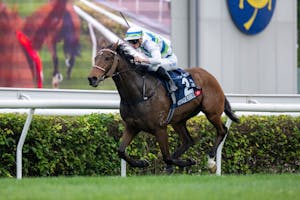5 technological advancements propelling horse racing forward

Keeneland (Photo courtesy of Keeneland)
Technology advances at a dizzying pace, influencing seemingly every aspect of life. Even a sport as old as Thoroughbred horse racing is changing with the times.
New technologies—and established technologies used in new ways—are improving equine safety and data analysis across many areas of horse racing. Five examples from recent years include the following:
Wearable biometric sensors for horse stride analysis
One of the most exciting technological advancements in horse racing is the use of wearable biometric sensors to measure horse performance and well-being. The technology offers the potential to sharply reduce catastrophic injuries by detecting brewing issues early on.
An example is the StrideSAFE technology that has been used at a variety of racetracks, including historic Keeneland. When installed in a horse’s saddlecloth, StrideSAFE compiles 2,400 data points per second, analyzing stride and performance to create a profile for each horse. Minute stride changes during exercise or in a race, which might not be detectable by traditional means, can be picked up by StrideSAFE and used to spot trouble before it gets serious.
StrideSAFE and similar technologies continue to advance. Artificial intelligence (AI) offers the opportunity to glean greater insights from the wealth of data, so the future of wearable biometric sensors in horse racing is exciting.
Improved medical technology for health diagnostics
In the quest to detect and treat developing issues before they turn into catastrophic injuries, horse racing has embraced the use of modern medical imaging technologies that go far beyond traditional X-rays. Magnetic resonance imaging (MRI) and computerized tomography (CT) scans are two examples, along with positron emission tomography (PET) scans.
In late 2019, Santa Anita installed a special PET scanner onsite. The device was designed to conduct scans on standing horses, simplifying the procedure. Issues that might have gone undetected using other means can now be brought to light, and Santa Anita’s PET scanner is credited with reducing the rate of catastrophic injuries.
Since installing the LongMILE (@equinepet) #MILEPET scanner on our campus in 2020, leading diagnostic imaging experts from #PennVet & @ucdavisvetmed have collaborated to advance the understanding and application of this powerful technology across all spectrums of #equinemedicine. pic.twitter.com/bR6TBta6Zj
— New Bolton Center (@NewBoltonCenter) May 11, 2023
Advanced GPS systems for race analytics
For decades, relatively little data was recorded about the running of any given horse race. The positions of the horses, and the margins between them, were determined by sight. And the elapsed time posted by the leader at each stage of the race was noted, but the times of horses racing behind the leader went unrecorded.
But times have changed. Equibase, the official database for racing information in the U.S. and Canada, has partnered with Total Performance Data to use GPS technology for compiling in-depth racing data at a bevy of North American racetracks. The times posted by every horse are now recorded at regular intervals (every sixteenth of a mile), allowing far greater insight into pace and performance.
In addition, the GPS systems record lots of other data pertaining to the performance of each horse, including average speed in miles per hour, stride length, number of strides, distance traveled, and more.

Digital Horse Tattoo Microchip (Courtesy of TRPB)
Cutting-edge maintenance for racing surfaces
The maintenance of racing surfaces has come a long way. Much work has been done to create consistent surfaces that provide even footing all the way around a track, lessening the likelihood of equine injuries. Efforts have even been made to ensure similarities in racing surfaces between racetracks so horses shipping from one to the other can make the switch seamlessly. For example, in 2017 the composition, banking, and grading of the dirt track at Del Mar was modified so it would resemble the surface at nearby Santa Anita.
Many factors are considered when maintaining racing surfaces, including the depth of the cushion (the fluffy uppermost surface of a dirt or synthetic track), the grip of the track (which affects how much horse hooves slide forward or backward while running), and the condition of the base underneath the cushion. The Racing Surfaces Testing Laboratory has developed standardized tests to analyze racing surfaces using a wide variety of scientific means, all with the goal of improving racehorse safety.
Digital tattoos for horse identification
Historically, racehorses were identified using unique lip tattoos. Before a horse would be allowed to race, the tattoo would be checked to confirm that the horse in the paddock was the correct one.
In the late 2010s, the Thoroughbred Racing Protective Bureau began transitioning from physical tattoos to digital tattoos, which use a small embedded microchip and photographs to confirm the identity of each horse. Digital tattoos have brought horse identification into the modern era and offer many benefits, such as eradicating the problem of physical tattoos fading with time.
The future is bright
Horse racing is one of the oldest sports in existence, and centuries-old traditions abound. But the moves to embrace technologies like wearable biometric sensors, PET scanners, GPS systems and more are carrying the sport forward to a safer and brighter future.

Churchill Downs, Inc. Equine Medical Center (Photo courtesy of CDI)



